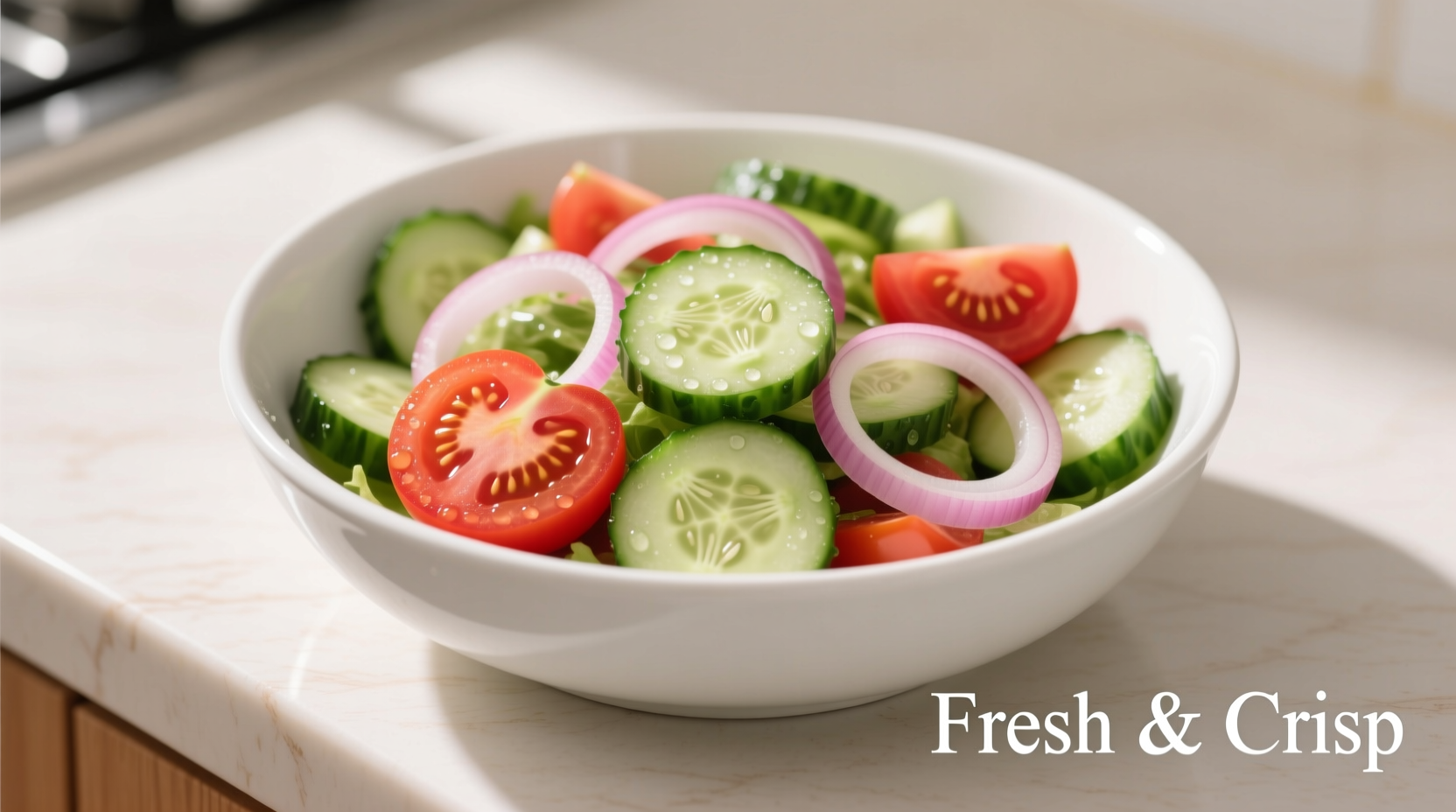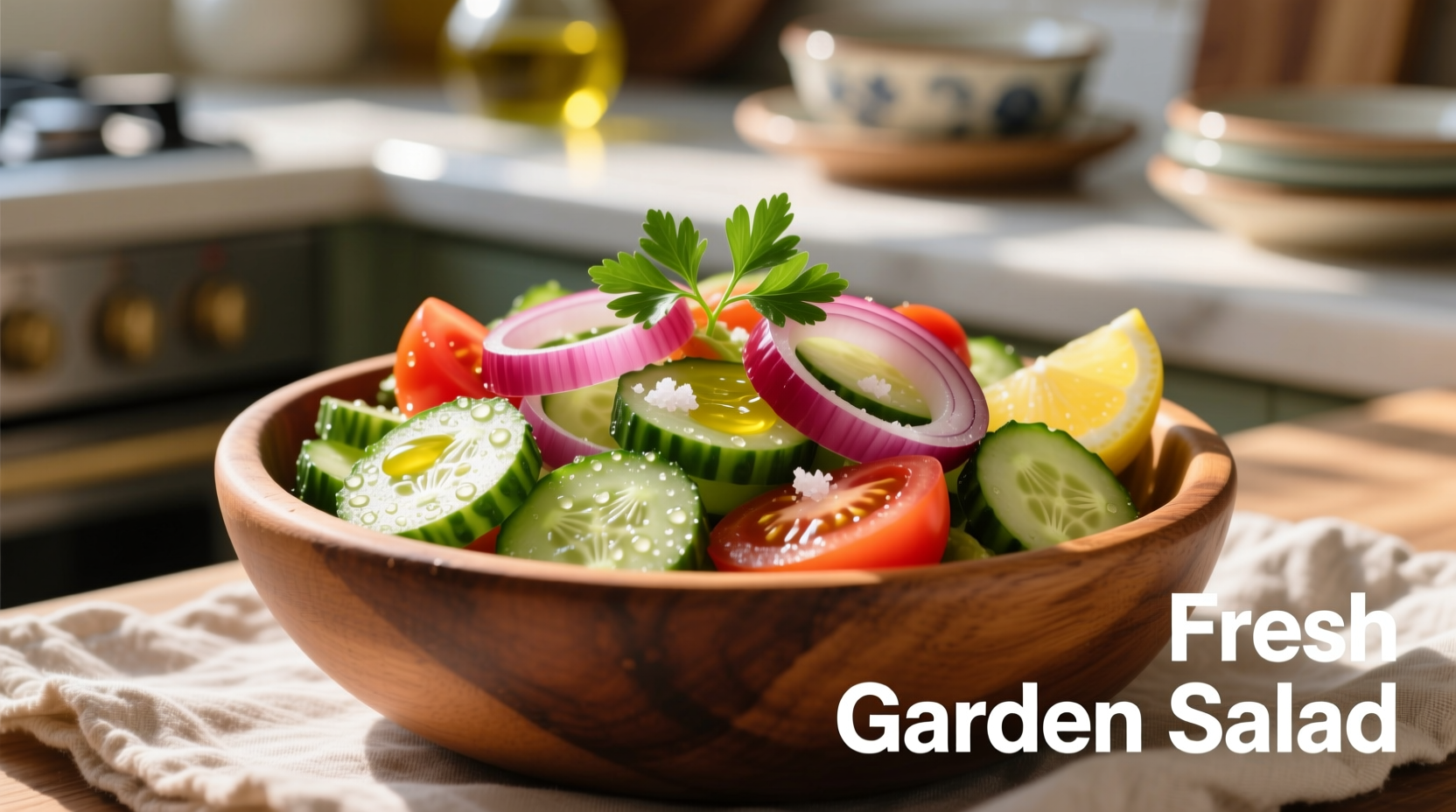Nothing beats a simple vegetable salad when temperatures rise. As a chef who's worked in both Michelin-starred kitchens and casual beachside eateries, I've perfected this cucumber onion and tomato salad recipe through years of testing different ratios, preparation techniques, and ingredient combinations. The magic lies in balancing the natural sweetness of ripe tomatoes with the crisp freshness of cucumbers and the subtle bite of red onions.
Why This Salad Works: The Science of Simplicity
Unlike complicated salads requiring special equipment or hard-to-find ingredients, this three-vegetable combination follows fundamental culinary principles that professional chefs rely on. The high water content in cucumbers (95%) and tomatoes (94%) creates natural hydration, while red onions contribute quercetin, a powerful antioxidant. When properly prepared, these ingredients create a salad that's both refreshing and nutritionally balanced.
Ingredient Selection: Quality Matters
The success of your cucumber tomato onion salad depends entirely on ingredient quality. Here's what to look for:
- Cucumbers: English or Persian varieties work best—they're less watery with fewer seeds
- Tomatoes: Vine-ripened Roma or heirloom tomatoes provide the perfect balance of sweetness and acidity
- Onions: Red onions offer the ideal color contrast and milder flavor profile
- Olive oil: Extra virgin with a grassy, peppery finish enhances vegetable flavors
- Vinegar: Red wine vinegar creates the perfect acidic balance without overpowering

Preparation Techniques That Make the Difference
Professional chefs use specific methods to maximize flavor and texture in this simple salad:
- Salt cucumbers first: Toss sliced cucumbers with ½ teaspoon salt and let drain for 10 minutes to prevent watery salad
- Soak onions: Place thinly sliced red onions in ice water for 15 minutes to mellow their sharpness
- Chop tomatoes properly: Cut tomatoes into uniform ½-inch pieces and add them last to maintain structure
- Dress at the right moment: Add dressing just before serving to keep vegetables crisp
- Hand-toss gently: Use clean hands for the most even coating without crushing ingredients
| Ingredient | Calories (per 100g) | Key Nutrients | Seasonal Peak |
|---|---|---|---|
| Cucumber | 15 | Vitamin K, Potassium, Magnesium | June-August |
| Tomato | 18 | Vitamin C, Lycopene, Potassium | July-September |
| Red Onion | 40 | Quercetin, Vitamin C, Chromium | Year-round |
This nutritional comparison, based on USDA FoodData Central research, shows why this simple combination creates such a nutritionally balanced dish. The complementary nutrient profiles provide hydration, antioxidants, and essential vitamins without excessive calories.
When This Salad Shines: Context Boundaries
Understanding when to serve this salad ensures optimal enjoyment. This fresh vegetable combination works best:
- During warm weather months when vegetables are at peak freshness
- Alongside grilled proteins like chicken, fish, or lamb
- As a palate cleanser between rich courses
- With Mediterranean or Middle Eastern cuisine pairings
Conversely, this salad falls short when:
- Using out-of-season, underripe tomatoes (winter months)
- Served with delicate dishes that could be overwhelmed
- Prepared more than 30 minutes before serving (becomes soggy)
- As the sole component of a meal without protein addition
Evolution of the Classic Salad
This simple vegetable combination has roots in Mediterranean cuisine dating back centuries. Historical food records show similar preparations appearing in:
- 16th century: Ottoman Empire cookbooks featuring "domates salatası" with tomatoes after their introduction from the Americas
- 19th century: Greek village recipes combining seasonal vegetables with olive oil and vinegar
- Mid-20th century: Spanish "ensalada campera" becoming popular with tomato and cucumber as key ingredients
- Today: Global variations appearing in cookbooks from California to Australia, maintaining the core vegetable trio
The enduring popularity of this basic combination demonstrates how simplicity often triumphs over complexity in fresh vegetable preparation.
Three Chef-Approved Variations
Once you've mastered the basic cucumber onion and tomato salad, try these professional variations:
Mediterranean Style
Add ¼ cup crumbled feta cheese, 10 Kalamata olives (pitted and sliced), and 2 tablespoons fresh oregano. Replace red wine vinegar with lemon juice for brighter acidity.
Mexican-Inspired
Substitute red onions with white onions, add 1 diced jalapeño (seeds removed), ¼ cup chopped cilantro, and lime juice instead of vinegar. Top with avocado slices just before serving.
Asian Fusion
Use rice vinegar instead of red wine vinegar, add 1 teaspoon sesame oil to the dressing, and garnish with toasted sesame seeds and thinly sliced scallions instead of red onions.
Serving and Storage Tips
For best results with your fresh cucumber tomato onion salad:
- Serve immediately: This salad is best enjoyed within 30 minutes of preparation
- Chill serving bowls: Place bowls in freezer for 10 minutes before assembling
- Storage limitations: Keeps for up to 24 hours refrigerated, but texture deteriorates
- Revival trick: If salad becomes watery, drain excess liquid and add a splash of fresh dressing
- Protein pairing: Add grilled chicken, chickpeas, or white beans to make it a complete meal
Remember that the beauty of this simple salad lies in its freshness. Unlike cooked dishes that often improve with time, this vegetable combination delivers its peak experience when served immediately after preparation.











 浙公网安备
33010002000092号
浙公网安备
33010002000092号 浙B2-20120091-4
浙B2-20120091-4